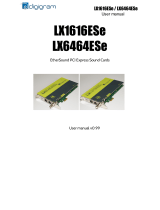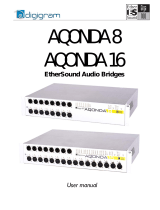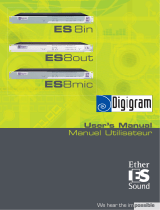Page is loading ...

D i g i g r a m
LX6464ES
EtherSound PCI Sound Card
User’s manual

D i g i g r a m
2
For technical support,
please contact your supplier
Digigram S.A.
Parc de Pré Milliet, 38330 Montbonnot - FRANCE
Tel: +33 (0)4 76 52 55 01• Fax: +33 (0) 4 76 52 53 07• E-mail: info@digigram.com
Digigram Inc.
2000 North 14th Street - Suite 530, Arlington, VA 22201-USA
Tel: +1 703 875 9100 • Fax: +1 703 875 9161 • E-mail: input@digigram.com
Digigram Asia Pte Ltd.
350 Orchard Road - #19-07 Shaw House Singapore, 238868-SINGAPORE
Tel: +65 6291 2234• Fax: +52 777 318 37 62• E-mail: [email protected]

LX6464ES
User’s Manual
3
Table of Contents
INFORMATION FOR THE USER
.................................................................................4
IMPORTANT NOTICE
...........................................................................................................5
CONTENTS OF THIS PACKAGE
.................................................................................5
FEATURES
........................................................................................................................................6
LX6464ES main hardware features.........................................................................................6
Main software features.................................................................................................................6
EtherSound features......................................................................................................................6
HARDWARE REQUIREMENTS
.....................................................................................7
Minimum requirements ................................................................................................................7
Software requirements..................................................................................................................7
Supported operating systems......................................................................................................7
HARDWARE INSTALLATION
.......................................................................................7
Installing the card...........................................................................................................................7
Interrupt and memory address...................................................................................................7
SOFTWARE INSTALLATION
..........................................................................................7
Installation under XP, Windows Server 2003, and Windows Vista.................................8
Removing the driver under Windows XP and Windows Server 2003............................9
Removing the driver under Windows Vista.............................................................................9
HOW TO CHECK THE INSTALLATION
............................................................10
DIRECTSOUND CONTROL PANEL
.......................................................................11
ASIO CONTROL PANEL
...................................................................................................11
CLOCK AND ROUTING
....................................................................................................11
SPECIFICATIONS
....................................................................................................................12
Configuration............................................................................................................................. 12
Inputs/Outputs.......................................................................................................................... 12
Connectors ................................................................................................................................. 12
EtherSound ................................................................................................................................ 13
Audio specifications.................................................................................................................. 13
Development environments................................................................................................... 13
APPENDICES
...............................................................................................................................14
LX6464ES schematic diagram ............................................................................................ 14
Connectors ................................................................................................................................. 14
Copyright 2007 Digigram. All rights reserved.
No portion of this manual may be reproduced without prior written consent from Digigram. The copyright protection
claimed here includes photocopying, translation and/or reformatting of the information contained in this manual.
While every effort has been made to ensure accuracy, Digigram is not responsible for errors and omissions, and
reserves the right to make improvements or changes in the products and programs described without notice.
Digigram, the Digigram logo, and LX6464ES are registered trademarks or trademarks of Digigram S.A.. All other
trademarks are property of their respective holders.

D i g i g r a m
4
INFORMATION FOR THE USER
This device complies with part 15 of FCC rules. Operation is subject to the following
two conditions: (1) This device may not cause harmful interference, and (2) This device
must accept any interference received, including interference that may cause undesired
operation.
This equipment has been tested and found to comply with the limits for a CLASS B
digital device, pursuant to Part 15 of the FCC Rules. These limits are designed to
provide reasonable protection against harmful interference in a residential installation.
This equipment generates, uses, and can radiate radio frequency energy and, if not
installed and used in accordance with the instructions contained in this data sheet, may
cause harmful interference to radio and television communications. However, there is
no guarantee that interference will not occur in a particular installation.
If this equipment does cause harmful interference to radio or television reception, which
can be determined by turning the equipment off and on, the user is encouraged to try to
correct the interference by one or more of the following measures:
* reorient or relocate the receiving antenna
* increase the separation between the equipment and the receiver
* connect the equipment into an outlet on a circuit different from that of the receiver
* consult the dealer or an experienced audio television technician.
Note: Connecting this device to peripheral devices that do not comply with CLASS B
requirements or using an unshielded peripheral data cable could also result in
harmful interference to radio or television reception. The user is cautioned
that any changes or modifications not expressly approved by the party
responsible for compliance could void the user’s authority to operate this
equipment. To ensure that the use of this product does not contribute to
interference, it is necessary to use shielded I/O cables.
Warning:
Electrostatic discharge (ESD) can damage several
components on the board. To avoid such damage in
handling the board, take the following precautions:
Bring the device and everything that contacts it to
ground potential by providing a conductive surface and
discharge paths. As a minimum, observe these
precautions:
• Disconnect all power and signal sources.
• Place the device on a grounded conductive work surface.
• Ground yourself via a grounding wrist strap or by holding a grounded
object.
• Ground any tool that will contact the device.

LX6464ES
User’s Manual
5
IMPORTANT NOTICE
This card has been tested and found to comply with the following standards:
• International: CISPR22 Class B.
• Europe: EMC 89/336/CEE (1992) specifications.
• United States: FCC Rules-Part 15-Class B (digital device).
CONTENTS OF THIS PACKAGE
Thank you for purchasing a Digigram LX EtherSound PCI sound card.
The package consists of the following components:
• the LX6464ES sound card,
• the User’s Manual at hand
• a CD-Rom*
• a registration form*
*These items are not delivered with the OEM version.

D i g i g r a m
6
FEATURES
The LX6464ES is an audio card for PCI bus. It is Universal PCI (32-bit/66
MHz), which means it can be plugged in 32-bit/33 MHz 5 V keyed PCI slots
as well as in 64-bit/66 MHz 3.3 V keyed PCI slots. The card IS also
compatible with PCI-X interfaces.
LX6464ES main hardware features
• 64 EtherSound ES-100 mono inputs at 44.1 kHz or 48 kHz
• 64 EtherSound ES-100 mono outputs at 44.1 kHz or 48 kHz
• 1 standard Word Clock input
Main software features
• Real-time, simultaneous record and playback in PCM (16 and 24 bits)
• Low latency DirectSound and ASIO drivers
EtherSound features
• EtherSound ES-100 compatible
• The card can generate the network audio clock, or it can synchronize on
the network audio clock
• Network clock frequencies supported:
48 kHz if the card itself generates the audio clock source for the network
44.1 kHz or 48 kHz if the card synchronizes on the EtherSound network
or on an external Word Clock
• Audio sampling frequencies supported:
48 kHz, 96 kHz, 192 kHz at a network clock frequency of 48 kHz
∗
44.1 kHz, 88.2 kHz, 176.4 kHz at a network clock frequency of 44.1 kHz
∗
Note: the audio sampling frequency defines the number of available
inputs/outputs:
at 88.2 kHz or 96 kHz: 32 inputs and 32 outputs
at 176.4 kHz or 192 kHz: 16 inputs and 16 outputs
∗
For the management of these modes, please refer to the corresponding question on our web
site in the FAQ section

LX6464ES
User’s Manual
7
HARDWARE REQUIREMENTS
Minimum requirements
PC with one free PCI or PCI-X slot (5 V or 3.3 V)
CPU power and memory required depend on the operating system and on the
audio application used.
Software requirements
The LX6464ES requires installation of the drivers included in LX6464ES Kit
version 1.00 or higher. This kit includes:
• a WDM DirectSound driver
• an ASIO driver
Supported operating systems
LX6464ES cards run under Windows Server 2003
∗
, Windows XP
∗
, and
Windows Vista
∗
.
HARDWARE INSTALLATION
The card has to be installed in the computer prior to installing its driver.
Installing the card
Gently plug the card in a free PCI slot and press it down to position it firmly.
Tighten the screw.
Interrupt and memory address
Hardware interrupt and addresses are automatically set up at start-up by the
PCI PnP BIOS.
SOFTWARE INSTALLATION
Note: the installation of the software requires administrator rights on your
computer
Please visit the Digigram web site at www.digigram.com for the most recent
driver.
In case you run a specific application developed or installed by a Digigram
Partner, this application might require the use of a specific driver version. In
this case, make sure that the updated driver has been approved by your
supplier.
∗
version 32 bits

D i g i g r a m
8
Installation under XP, Windows Server 2003, and
Windows Vista
• Shut down your computer and insert the LX6464ES card.
• Restart your computer.
• Click on Cancel if the “Found New Hardware” Wizard appears.
• Double-click on the LX6464 Kit vxx.msi/ Digigram LX6464ES Kit
for Vista icon to launch the driver installation.
• A welcome message is displayed, click Next to continue.
• The “License Agreement” window appears: read it, and click on
“I accept the terms in the license agreement” to approve it.
• In the “Custom Setup” window, the “Drivers for the LX6464ES
board” are displayed; by default, both WDM DirectSound and ASIO
LX are installed. Next.
• In the “Ready to Install the Program Window”, click on Install to start
copying the files.
• Note:
In case you use an unsigned driver version, the “Digital
Signature Not Found” message may appear because a non-
Microsoft software is about to be installed.
Click on Continue in the “Hardware installation” window.
• Under Windows Vista:
Click Allow in the “User Account Control” window.
Click Install in the “Windows Security” window.
• Click on Continue in the “Hardware installation” window.
• Once the files have been copied to your disk and the driver has been
started, the firmware version of your card will be checked against the
version included in the driver package.
WARNING:
if the firmware of your card requires an update, it will start
automatically at this stage. The update is recommended, it ensures optimal
performances and robustness of the system. The update MUST IN NO CASE BE
INTERRUPTED. If you do so, the card will have to be returned to our After Sales
Service.
• The “DirectSound Device Builder application” will prompt you to define
your DirectSound devices (For details, please refer to the application’s
online help).
• To use the card via the DirectSound interface, you’ll have to configure the
devices you intend to use in the “DirectSound Device Builder” application,
which is launched automatically. One DirectSound stereo device is
declared (channels 1 and 2). You can declare additional devices by using
the “+” button, then enter the first channel used by this device, the number
of channels, and – under Windows Server 2003 nd XP - the name of the

LX6464ES
User’s Manual
9
device; under Windows Vista, please use the Vista Control Panel ‘Sound’
to name your devices. A DirectSound device can be multichannel (the
application must be able to manage this type of device). For more details,
please refer to the online help of this application.
Note
: The “DirectSound Device Builder” application can be launched at any
time once the driver of the LX6464ES installed (
<Start>
,
<Programs>
,
<Digigram>
,
<Digigram Control Center>
). It is necessary to reboot
the computer to apply the changes.
• In the “Digigram drivers” window, select the granularity
∗
of the
audio data. A granularity of 128 samples is the default value
(recommended). Under DirectSound, selecting a lower value (64,
32) will decrease the latency, but limits the number of devices that
can be used simultaneously without venturing possible dropouts. .
Under ASIO, granularity may be set to 32 samples, as the ASIO
driver uses one single 64-channel device .
For more details, please see the Control Panel’s online help or the
“Performance” section of the DirectSound Device Builder’s or the
ASIO control panel’s online help.
Click on Ok.
• Click on the Finish button to complete the driver installation.
Removing the driver under Windows XP and Windows
Server 2003
• Open the Windows Control Panel and double-click on the
Add/Remove Software icon.
• Select “Digigram LX6464ES Kit …”, and Change/Remove.
• Select Remove.
• Follow the instructions to finish the driver removal.
Removing the driver under Windows Vista
• Open the Windows Control Panel and double-click on the
Programs and Features icon.
• Select “Digigram LX6464ES Kit …”, and Change/Remove.
• Select Uninstall in the HR Runtime window.
• Follow the instructions to finish removing the driver.
∗
The granularity corresponds to the computing unit of the card. It is expressed in samples.

D i g i g r a m
10
HOW TO CHECK THE
INSTALLATION
Once driver and card installed according to the procedure described in this
manual, you can verify that the card works correctly as follows:
• Windows XP and Server 2003:
Menu <Start>, <Settings>, <Control panel>, <Sound and
Multimedia>, tab “Audio”, <Default device> (Playback device,
Recording device). Pull-down menus allow for the card’s DirectSound
devices as declared during installation (e.g. “LX6464ES -01 (WDM)” by
default for the card’s first stereo channel). The card can be used with any
application based on DirectSound or DirectKS (see pages hereafter).
Windows Vista:
<Control Panel>, <Hardware and Sound>, <Sound> (Tab Playback,
Recording): the declared devices are displayed. Check ‘Properties’ and
click “Test” button.
• If the ASIO option has been selected during installation, the card is
visible through any ASIO compliant application.
If the card is not displayed:
• Make sure that the box “Drivers for the LX6464ES board” is checked
in the “Select components” window.
• Make sure that the card is correctly inserted in the PCI slot, and screwed
on the PC chassis.
• If necessary, uninstall the driver as described in this manual, and re-
install it.

LX6464ES
User’s Manual
11
DIRECTSOUND CONTROL PANEL
The card does not dispose of digital gain. Under the Windows ‘Volume’
control panel only a ‘Mute’ is available.
ASIO CONTROL PANEL
With the ASIO driver installed, the card’s settings can be adjusted through the
ASIO control panel. To launch this interface, go to <Start>, <Programs>,
<Digigram>, <ASIO HR Settings>.
For help on how to use this control panel, please refer to its on-line help.
CLOCK AND ROUTING
The clock management as well as the assignment of devices to EtherSound
channels (“I/O mapping”) are done through Digigram’s EScontrol application,
or a specific application conceived by one of our development partners.

D i g i g r a m
12
SPECIFICATIONS
Configuration
Bus/Format
Universal PCI (32-bit/66 MHz),
PCI-X compatible, master mode
Size 175 mm x 99 mm x 20 mm
Power requirements
(+3.3 V /+5 V / +12 V / -12 V)
1 A / 0.2 A / 0 A / 0 A
Operating:
temp / humidity
(non-condensing)
0°C / +50°C • 5% / 90%
Storage: temp / humidity
(non-condensing)
-5°C / +70°C • 0% / 95%
Inputs/Outputs
Inputs
64 EtherSound channels at 44.1 or 48 kHz
32 EtherSound channels at 88.2 kHz or 96 kHz
16 EtherSound channels à 176.4 kHz or 192 kHz
Outputs
64 EtherSound channels at 44.1 or 48 kHz
32 EtherSound channels at 88.2 kHz or 96 kHz
16 EtherSound channels à 176.4 kHz or 192 kHz
Other inputs
Word clock, 44.1 or 48 kHz
(can be used if card is the audio clock for the
EtherSound network)
Connectors
EtherSound IN (RJ45 female)
EtherSound OUT (RJ45 female)
Word Clock IN BNC female

LX6464ES
User’s Manual
13
EtherSound
Technology ES-100
Functions
Compatible with Ring Redundancy mode
Can generate the audio network clock in all
modes
Network clock frequencies
supported
Can generate a 48 KHz audio clock for the
EtherSound network
Can synchronize on an EtherSound network at
either 44.1 or 48 kHz
Other inputs
Word clock,
the card can generate a 44.1 or 48 kHz audio
clock synchronized on the Word Clock In
EtherSound virtual control
port
Virtual Ethernet interface (software) enabling an
application such as EScontrol, installed on the
same PC, to directly access an EtherSound
network with no need of an additional network
connection
Audio specifications
Audio sampling frequencies
supported
192 kHz, 96 kHz, 48 kHz
∗
(at 48 kHz network clock frequency
176.4 kHz, 88.2 kHz, 44.1 kHz
∗
(at 44.1 kHz network clock frequency)
Supported audio formats
PCM 16, 24, 24 bits “packed” (packets of 32 bits)
Development environments
Management WDM DirectSound, ASIO
Supported operating
systems
Windows XP
∗
, 2003 Server
∗
, and Windows Vista
∗
∗
For the management of these modes, please refer to the corresponding question on our web
site in the FAQ section
∗
32-bit version

D i g i g r a m
14
APPENDICES
LX6464ES schematic diagram
PCI BUS
EtherSound
Core
INTERFACE
Word Clock
CRYSTAL
EtherSound
OUT
EtherSound
IN
Connectors
LX6464ES
J1
J2
J3
J1 : EtherSound IN
J2 : EtherSound OUT
J3 : Word Clock IN
/






